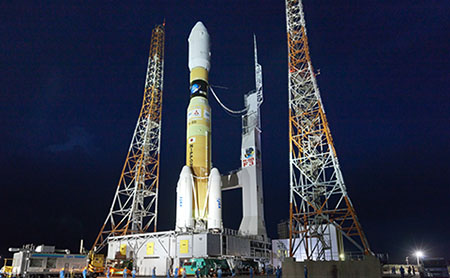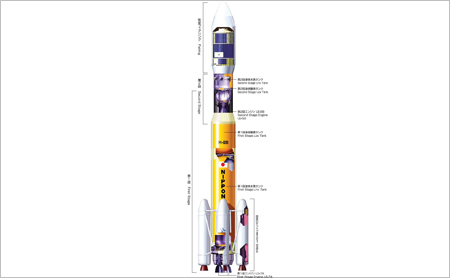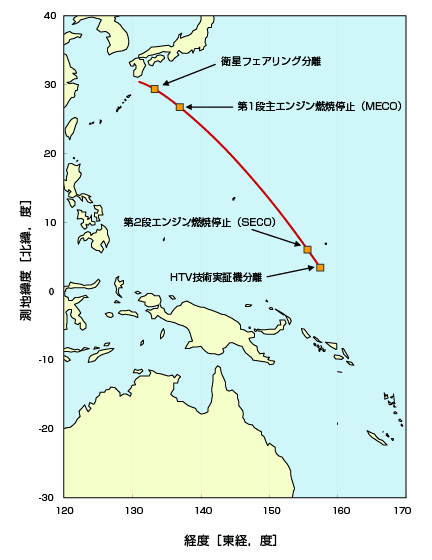About H-IIB Launch Vehicle
 |
Opening the Door to Future Space MissionJapan has been developing its own launch vehicles based onvarious research and experiments. Among such launch vehicles, the H-IIA Launch Vehicle has been supporting satellite andexplorer launch missions as a mainstay large-scale launch vehicle with high reliability. |
|---|
Project Topics
indexSuccessful Launch of the H-II Transfer Vehicle "KOUNOTORI9" aboard H-IIB Launch Vehicle No. 9
|
At exactly 31 minutes and 00 seconds past 2 o’clock on the morning of May 21, 2020, the H-II Transfer Vehicle known as "KOUNOTORI9" (HTV9), the cargo transporter to the International Space Station (ISS), was launched aboard H-IIB Launch Vehicle No. 9 (H-IIB F9) from the JAXA Tanegashima Space Center. H-IIB Vehicle light up in blue before its launch ©JAXA Messa... |
Press Release
index-
- May 21, 2020 (04:10) [release]
- Launch Results of the H-II Transfer Vehicle KOUNOTORI9 aboard H-IIB Vehicle No. 9
-
- Mar. 24, 2020 (14:00) [release]
- Launch Schedule of the H-II Transfer Vehicle KOUNOTORI9
Characteristics of H-IIB Launch Vehicle
1.Key Capacity Improvement: Clustering
|
The H-IIB launch vehicle is a two-stage rocket using liquid oxygen and liquid hydrogen as propellant and has four strap-on solid rocket boosters (SRB-A) powered by polibutadiene. |
 |
|---|
2.For Effective Development
|
At the time of launching HTV, the H-IIB will use a special fairing for HTV. However, in other parts, it will take over most of the specifications and structures of on-board equipments and ground systems already used for the H-IIA. These efforts are designed to reduce development risk and cost. Moreover, it will share the launch facility with the H-IIA and be launched from Yoshinobu Launch Pad of the Tanegashima Space Center. |
 |
|---|
Major Characteristics
Major Characteristics (H-IIB Test Flight)
| Length (m) | 56.6 |
|---|---|
| Mass (t) | 531 (without payload mass) |
| Guidance Method | Inertial Guidance Method |
| Item | ||||
|---|---|---|---|---|
| First Stage | Solid Rocket Booster (SRB-A) |
Second Stage | Payload Fairing(5S-H) | |
| Height (m) | 38 | 15 | 11 | 15 |
| Outside diameter (m) | 5.2 | 2.5 | 4.0 | 5.1 |
| Mass (t) | 202 | 306 (for four SRB-As in total) | 20 | 3.2 |
| Propellant mass (t) | 177.8 | 263.8 (for four SRB-As in total) | 16.6 | - |
| Thrust (kN)*1 | 2,196 | 9,220 | 137 | - |
| Combustion time (s) | 352 | 114 | 499 | - |
| Propellant type | Liquid oxygen/hydrogen | Polybutadiene composite solid propellant | Liquid oxygen/hydrogen | - |
| Propellant supply system | Turbo pump | - | Turbo pump | - |
| Impulse to weight ratio (s)*1 | 440 | 283.6 | 448 | - |
| Attitude control method | Gimbal | Movable nozzle | Gimbal gas jet system | - |
| Major onboard avionics | Guidance control equipment Telemetry transmitter |
- | Guidance control equipment Radar transponder Telemetry transmitter Command destruct system |
- |
| *1 | In vacuum. Solid rocket booster's thrust is set to the maximum value. |
|---|
H-IIB Launch Vehicle Launch Capacity
| Orbit | Altitude | Payloads |
|---|---|---|
| Orbit for HTV (Inclination:51.6 degrees)350km-460km16.5t |
Launch Records
| Flight No. | Launch Date | Payload |
|---|---|---|
| F9 | 5/21/2020 | H-II Transfer Vehicle "KOUNOTORI9" (HTV9) |
| F8 | 9/25/2019 | H-II Transfer Vehicle "KOUNOTORI8" (HTV8) |
| F7 | 9/23/2018 | H-II Transfer Vehicle "KOUNOTORI7" (HTV7) |
| F6 | 12/9/2016 | H-II Transfer Vehicle "KOUNOTORI6" (HTV6) |
| F5 | 8/19/2015 | H-II Transfer Vehicle "KOUNOTORI5" (HTV5) |
| F4 | 8/4/2013 | H-II Transfer Vehicle "KOUNOTORI4" (HTV4) |
| F3 | 7/21/2012 | H-II Transfer Vehicle "KOUNOTORI3" (HTV3) |
| F2 | 1/22/2011 | H-II Transfer Vehicle "KOUNOTORI2" (HTV2) |
| TF1 | 9/11/2009 | H-II Transfer Vehicle "KOUNOTORI" (HTV Demonstration Flight) |
Contents

- Feb. 18, 2009
- A New Stage in Japanese Space Transportation
 Large Image
Large Image